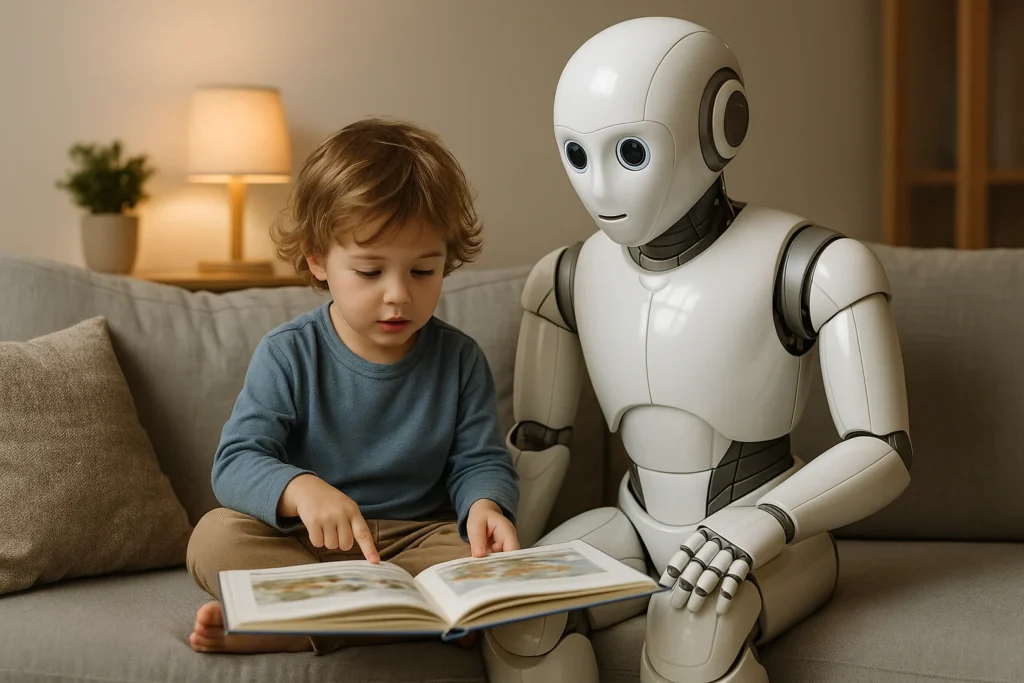Lena scrolled through urgent work messages at 8:45 PM, her 3-year-old son Leo clinging to her leg. “Story, Mama? Pwease?” Exhaustion washed over her like a tidal wave. Before guilt could fully set in, she tapped her smartwatch: “Eva, bedtime routine.” Across their Shanghai apartment, a 4-foot-tall humanoid with warm blue eyes whirred to life. “Hello, Leo! Shall we journey with the Very Hungry Caterpillar tonight?” As Eva’s soothing voice filled the room – complete with animated light projections showing the caterpillar’s munching path – Lena collapsed into her chair. Halfway across the world in a Dubai skyscraper, 5-year-old Ayesha giggled as her MisaRo robot corrected her Arabic pronunciation, while in suburban Chicago, Alexa soothed baby Mia with AI-generated lullabies after detecting pre-cry fussing. This quiet revolution is transforming nurseries globally, as artificial intelligence steps into the most intimate spaces of child-rearing.
The AI Caregiver Spectrum: From Voice Assistants to Emotional Companions
Today’s AI nannies exist on a sophisticated continuum, each filling unique niches in modern parenting:
1. Advanced Humanoid Companions ($5,000-$15,000)
- Leading Models: UBTECH’s Walker X (China), Emirati Robotics’ MisaRo (UAE), ROOBO’s Pudding S (China), Toyota’s Kirobo Mini (Japan/US)
- Capabilities Beyond Imagination:
- Adaptive Mobility: Navigates complex home environments using LIDAR and 3D vision, avoids stairs and toys
- Emotional Recognition: Analyzes vocal tone and facial expressions to detect frustration/excitement
- Haptic Interaction: Soft silicone skin with warmth simulation and gentle vibration for “comfort hugs”
- Educational Personalization: Tracks learning progress and adjusts math/language challenges daily
- Cultural Customization: MisaRo teaches Emirati traditions; Walker X emphasizes Chinese calligraphy
Case Study: Dubai’s Robo-Nanny Boom
Fatima Al-Fassi watches her daughter Ayesha practice Quranic verses with MisaRo: “It corrects tajweed (recitation rules) better than I can. During Ramadan, it adjusted bedtime stories to Islamic themes.” UAE’s Ministry of AI reports 43% growth in educational robot sales since 2023.
2. AI Voice Ecosystems ($100-$300)
- Next-Gen Platforms: Amazon’s Alexa Together Kids+, Google’s Nest Hub Kids Space, Xiaomi’s Xiao AI Tutor, Tencent’s BabyQ
- Transformative Features:
- Emotional Support Algorithms: Detects sadness in voice and offers coping strategies (“Let’s breathe with Cloud the Calm Koala”)
- Multilingual Code-Switching: Flips between languages mid-conversation for immersion learning
- Custom Story Engine: Generates original tales featuring child’s friends and interests
- Health Integration: Syncs with wearables to suggest activities based on sleep quality
- Ethics Training: Role-plays kindness scenarios (“How should Kai share his toy?”)
Real-World Impact: Beijing
Chen Wei’s Xiao AI tutor taught his daughter English through personalized dinosaur adventures: “Her vocabulary surpassed mine in 6 months. The AI noticed her stutter and adjusted pronunciation exercises.”
3. AI-Powered Safety Systems
- Next-Level Monitoring:
- Cubo AI Plus: Uses computer vision to detect breathing abnormalities during sleep
- Miku Pro Monitor: Tracks developmental milestones through movement analysis
- Owlet Dream Sock: AI predicts illness through subtle vital sign changes
- SEER Autism Screen: Flags early social interaction patterns through play analysis
Chicago Father’s Testimonial
Michael Rinaldi credits his Owlet with detecting early RSV symptoms: “The AI noticed oxygen dips before visible symptoms. Doctors said it prevented hospitalization.”
The Global Surge: Why AI Nannies Are Exploding Now
1. The Perfect Storm of Parental Pressure
- China’s “Double Reduction” Backfire: While reducing homework, policy created vacuum filled by AI tutors
- UAE’s 70-Hour Work Culture: Highest average working hours in GCC region
- America’s “Sandwich Generation”: 53% of parents care for children and aging parents simultaneously
- Global Fertility Decline: More singleton children receiving “tech undivided attention”
2. Technological Quantum Leaps

3. Cultural Paradigm Shifts
- China: “Quality Education Economy” worth $100B prioritizes early tech advantage
- UAE: National AI Strategy 2031 mandates 40% preschool tech integration
- USA: Post-pandemic acceptance of “asynchronous parenting” via digital tools
The Hidden Curriculum: What AI Really Teaches Children
Documented Benefits
- Stanford Study (2024): Children using language bots showed 28% faster multilingual acquisition
- OECD Report: AI personalized learning closed socioeconomic gaps in early math skills
- Dubai Early Childhood Center: Special needs children showed 40% improvement in emotional regulation using MisaRo
Invisible Impacts
Emotional Development Quandaries
- The “Mirror Neuron” Dilemma: Can children learn empathy from algorithms? (Dr. Emilia Rodriguez, MIT)
- Attachment Red Flags: 32% of surveyed toddlers preferred robot comfort over parents during distress (Tokyo Study)
- Emotional Scripting: Repetition of AI phrases like “I understand you’re sad” without genuine comprehension
Data Privacy Nightmares
- China’s “Smart Baby” Database: Government access to 500M+ early childhood data points
- Amazon’s Voice Blueprints: Stored recordings used to train advertising algorithms
- Hackable Vulnerabilities: 2023 breach of Cubo AI exposed 2.1 million baby monitor feeds
Cognitive Trade-offs
- Diminished Creativity: Structured AI play reduced imaginative scenarios by 65% (Cambridge Research)
- Attention Fragmentation: Constant AI interaction correlated with shorter focus spans
- Algorithmic Bias: Language bots reinforcing gender stereotypes in career stories
Cultural Contrasts: How Nations Embrace AI Parenting
China’s “Iron Nanny” Phenomenon
- Tech: ROOBO Pudding S dominates 68% market share
- Parenting Motto: “Victory through early optimization”
- Controversy: Government-mandated playtime limits on educational bots
UAE’s Luxury AI Integration
- MisaRo Customization: Gold-plated options, custom scent modules (dates/oud)
- Cultural Guardianship: Algorithms vetted by Islamic education boards
- Privacy Paradox: Willingness to trade data for premium services
America’s Anxious Adoption
- Hybrid Approach: 73% use AI for tasks but limit emotional interaction
- Regulatory Vacuum: No federal laws governing child-AI data collection
- Social Divide: $25,000 nanny robots creating “robotic privilege gap”
Voices From the Digital Nursery
Beijing Mother’s Dilemma
“Pudding taught Li Wei to read at 3,” admits Ting Zhao. “But when he scraped his knee, he asked ‘Where’s Pudding’s band-aid song?’ before seeking me. That haunts me.”
Dubai Child Psychologist’s Warning
Dr. Amira Khalid observes: “We’re seeing ‘robotic regression’ – children mimicking AI’s flat affect during human interactions. The clinical term is Synthetic Interaction Syndrome.”
Silicon Valley Whistleblower
Former Google Kids designer Raj Mehta confesses: “We track emotional vulnerabilities to increase engagement. That ‘calming koala’? Its effectiveness is measured for ad targeting.”
Navigating the Algorithmic Playground: A Parent’s Guide
Essential Safeguards
- The 30-Minute Rule: Never exceed continuous AI interaction time matching child’s age (3 years=30 min)
- Data Lockdown: Demand end-to-end encryption and opt-out of cloud storage
- Human Primacy: Always provide comfort before AI responds to distress
- Algorithmic Audits: Review story content for bias monthly
- Tech-Free Zones: Preserve beds and meal tables as sacred spaces
Future-Proofing Childhood
- EU’s Proposed Regulations: Ban on emotion recognition for under-5s
- UNICEF’s “Child First” AI Principles: Prioritizing developmental needs over data collection
- Biometric Firewalls: Emerging tech to prevent facial data extraction
The Irreplaceable Human Heart
As Eva finished Leo’s story in Shanghai, the robot offered: “Shall we practice counting stars?” Lena intervened, scooping up her son. “Not tonight, Eva. We’ll find real stars.” She carried Leo to the balcony, pointing at the faint celestial lights piercing the city’s glow. “See? That one’s blinking just for you.” Leo’s wonder-filled gaze reflected genuine starlight – not programmed LEDs. In that moment, Lena understood: AI could teach counting, but only humans could inspire wonder. It could mimic comfort, but never replace the healing power of a mother’s heartbeat against a child’s cheek.
The AI nanny revolution presents not just technological challenges, but profound questions about the essence of childhood. As we navigate this frontier, our compass must be calibrated to one truth: technology should kneel before human connection, not the reverse. The future belongs to children who master algorithms – not those mastered by them.




jzgpan